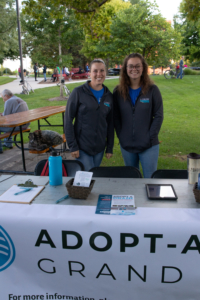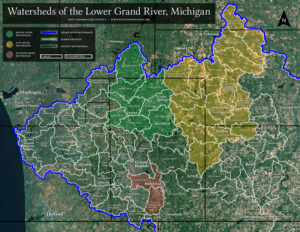By Dan Christmann
Winter last year (2018-19 for those of you browsing through the archive) was manic depressive. Michigan’s weather is always unpredictable, but this was on a different level. I remember spending three days huddled under a blanket in my apartment, wishing I’d chosen a place for it’s insulation rather than its aesthetics. From the nine-foot windows of that house in Grand Rapids’ Heritage Hill neighborhood, I watched as winds from the north carved the snowdrifts into waves.
A week later, it was in the mid-40’s and the streets became rivers.
It was about the time that I stepped outside in a light coat and tried to fjord Madison Avenue to my car that I noticed a mound of ice encasing a storm drain in front of my house. I tried to chip away at it, but I was already late for work and I didn’t have a pickax handy. I left the drain to it’s fate and floundered across town.
Orphaned Storm Drains
Meeting Cara Decker, the Storm Water Coordinator for the Lower Grand River Organization of Watersheds (LGROW) brought all these memories bobbing back to the surface. The program we were to discuss addresses this problem directly. People know storm drains are necessary, but don’t remember that they’re there. It’s that way with a lot of infrastructure: we only notice when it’s broken.
 This is one of the reasons LGROW created their Adopt-A-Drain program: to help people remember. Adopt-A-Drain isn’t particularly complicated. It’s essentially a mapping software that extends and digitizes Grand Rapids’ Basin Buddy program. Eventually LGROW’s map will cover every storm drain in the lower Grand River watershed. Users who are so inclined can access the map, claim a drain near to them, and pledge to keep it clear. The whole process takes less than five minutes, and you’ll be able to rest easy knowing your front yard will not become a lake.
This is one of the reasons LGROW created their Adopt-A-Drain program: to help people remember. Adopt-A-Drain isn’t particularly complicated. It’s essentially a mapping software that extends and digitizes Grand Rapids’ Basin Buddy program. Eventually LGROW’s map will cover every storm drain in the lower Grand River watershed. Users who are so inclined can access the map, claim a drain near to them, and pledge to keep it clear. The whole process takes less than five minutes, and you’ll be able to rest easy knowing your front yard will not become a lake.
The process is even easier for folks who are already part of the Basin Buddy program: They’re already in the system. All they need to do to be a part of Adopt A Drain is create a password.
More than flooding

While I was there, Cara also let me know that storm drain cleaning isn’t just about flood prevention. “When it rains here in West Michigan,” Cara told me at LGROW’s riverside office, “the rain hits your house or hits like, the parking lot outside, and goes directly into the river. It doesn’t get treated or anything.” Whatever the rain picks up on its way also follows the same path. Trash, leaves, chemicals like nitrogen and phosphorous, and tar from asphalt, all dumped into the Grand and it’s surrounding tributaries. Detritus like this degrades the health of the river and the lake, our primary water source.
You can’t prevent all of this by cleaning storm drains. Grates won’t stop phosphorus and nitrogen, the primary cause of eutrophication in Lake Erie. But the drains do catch larger waste, and most of it shouldn’t be in the river. This debris causes flooding, and changes the balance of surrounding ecosystems when they make their way to the river.
Cleaning your drain regularly might not seem like a big deal. It’s not particularly glamorous. But it does make our water significantly cleaner, and lessens our individual impact on the environment. “In the environmental field, we talk a lot about things, and then people are like, what can I do?” Cara opined. “Sometimes you get too technical or too in the weeds about something, but this is something that you can do that has a direct impact.”
Sometimes it’s the simple, messy things that do the most good.
The Adopt-A-Drain program has been live for several months now. Find it, along with other ways to prevent the area around your house from turning into a swamp, at LGROW’s website, or find them in person plugging their service like they did at the Mayor’s Grand River Cleanup, pictured above.

